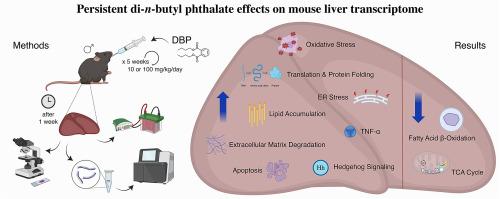邻苯二甲酸二正丁酯对肝脏转录组的持续影响:能量和脂质代谢途径受损。
IF 8.1
2区 环境科学与生态学
Q1 ENVIRONMENTAL SCIENCES
引用次数: 0
摘要
据报道,环境污染物邻苯二甲酸二丁酯(DBP)具有肝毒性,但其潜在的分子途径和病理过程仍不清楚。在此,我们利用 RNA 序列分析了雄性小鼠在口服 10 毫克/千克/天或 100 毫克/千克/天 DBP 五周后一周的持续肝转录效应。探索性转录组分析表明,10 毫克/千克/天组有五个差异表达基因 (DEG),100 毫克/千克/天组有十三个差异表达基因 (DEG)。基因组富集分析(Gene Set Enrichment Analysis,GSEA)可确定受影响的生物通路,而不是只关注单个基因。此外,我们发现在 10 毫克/千克/天的 DBP 组中,有 54 个 Reactome 通路上调,1 个下调;在 100 毫克/千克/天的 DBP 组中,有 29 个 Reactome 通路上调,13 个下调。根据 DEGs 和 GSEA 的发现,DBP 暴露会破坏几个关键的生物过程,包括蛋白质翻译、蛋白质折叠、细胞凋亡、刺猬信号转导、细胞外基质降解和能量/脂质代谢的改变。随后的肝组织分析证实了这些发现,显示暴露于 DBP 会诱发组织紊乱、氧化应激、脂质积累、TNF-α、ATP 和葡萄糖激酶水平升高。此外,代谢系统的几种核心蛋白质也受到了影响,主要表现为剂量反应模式。总之,这些结果表明 DBP 可导致肝脏应激和损伤,并表明 DBP 在非酒精性脂肪肝--全球最常见的肝病--的发展过程中具有潜在作用。本文章由计算机程序翻译,如有差异,请以英文原文为准。

Persistent effects of di-n-butyl phthalate on liver transcriptome: Impaired energy and lipid metabolic pathways
The environmental contaminant dibutyl phthalate (DBP) is reported to be hepatotoxic, but the underlying molecular pathways and pathological processes remain unclear. Here we used RNA-sequencing to characterize persistent hepatic transcriptional effects one week after the conclusion of five weeks oral exposure to 10 mg/kg/day or 100 mg/kg/day DBP in adult male mice. The exploratory transcriptome analysis demonstrated five differentially expressed genes (DEGs) in the 10 mg/kg/day group and 13 in the 100 mg/kg/day group. Gene Set Enrichment Analysis (GSEA), which identifies affected biological pathways rather than focusing solely on individual genes, revealed nine significantly enriched Reactome pathways shared by both DBP treatment groups. Additionally, we found 54 upregulated and one downregulated Reactome pathways in the 10 mg/kg/day DBP group, and 29 upregulated and 13 downregulated pathways in the 100 mg/kg/day DBP group. DBP exposure disrupted several key biological processes, including protein translation, protein folding, apoptosis, Hedgehog signaling, degradation of extracellular matrix and alterations in the energy/lipid metabolism. Subsequent liver tissue analysis confirmed that DBP exposure induced tissue disorganization, oxidative stress, lipid accumulation, increased TNF-α, ATP and glucokinase levels, and affected key metabolic proteins, predominantly in a dose-response manner. Overall, the results show that DBP can cause hepatic stress and damage and suggest a potential role for DBP in the development of non-alcoholic fatty liver disease, the most prevalent liver disease worldwide.
求助全文
通过发布文献求助,成功后即可免费获取论文全文。
去求助
来源期刊

Chemosphere
环境科学-环境科学
CiteScore
15.80
自引率
8.00%
发文量
4975
审稿时长
3.4 months
期刊介绍:
Chemosphere, being an international multidisciplinary journal, is dedicated to publishing original communications and review articles on chemicals in the environment. The scope covers a wide range of topics, including the identification, quantification, behavior, fate, toxicology, treatment, and remediation of chemicals in the bio-, hydro-, litho-, and atmosphere, ensuring the broad dissemination of research in this field.
 求助内容:
求助内容: 应助结果提醒方式:
应助结果提醒方式:


